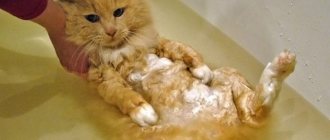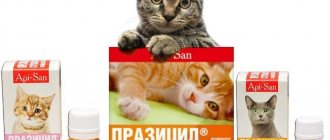13557Administration
1
Everyone has known about the unsettled relationship between cats and water for a long time. These fluffy and affectionate animals are accustomed to providing themselves with bathing procedures using their specific language. Hence, their owners have a logical question - do they need to wash cats?
Opinions on this matter are divided into two categorical camps - for and against. Most cats simply cannot tolerate water, and even more so, swimming. Therefore, the procedure at home can become stressful not only for the animal, but also for the owner. But this is only if you do not bathe your pets according to the rules.
© shutterstock
Options for how often you can wash your cat
The frequency and regularity of activities depends on individual factors: some animals need them periodically. Should you wash your cat? The need is often related to long hair, breed characteristics, age and health.
Washable cat
How often to wash a cat
Adult healthy cats that have not been sterilized require more frequent care. Under the influence of hormones, the sebaceous glands of boys produce more secretions, causing rapid contamination of the coat.
How often to wash a kitten
Baby hygiene begins no earlier than 3-4 months. - Until this age, the mother takes care of them. Veterinarians advise starting the first care after baby teeth fall out. Later - from 2 to 4 times a year.
Is it possible to wash a newborn cat? Attempts to bathe the baby at a younger age may lead to the mother refusing to feed due to the foreign odor from the pet shampoo.
Examples depending on the time of year
In winter, the number of procedures is reduced - the animal gets very cold and may catch a cold. In other seasons - depending on pollution or up to 3 times a year, but less is possible.
Do I need to wash my cat extra in hot weather? Experts say that you should not increase the frequency of activities in the summer - this will not save him from overheating, but will only disrupt the functioning of the sebaceous glands.
Depending on the age of the pet
Hygiene is carried out:
- the first - for British kittens and young representatives of other breeds at 3-4 months;
- for sexually mature individuals - 2-4 procedures per year;
- for the elderly - depending on health status.
How often can adult cats be bathed? As needed and as much contamination as possible, especially during estrus, but not more than once every 2 months.
Washing a Scottish cat
Influence of breed and coat length
Why do different breeds require their own grooming schedules? The frequency of washing depends on the length of the coat:
- for short-haired breeds - every 3-6 months;
- long-haired - every 2-4 months;
- sphinxes - it is preferable to wipe with wet wipes, bathe only in the summer heat.
Important! Most often, hygiene procedures are carried out on animals with white, peach and beige colors - every 2-3 months.
Examples of when cats should not be bathed
Water procedures are contraindicated:
- after surgical interventions - care is carried out no earlier than 2 weeks after surgery;
- in the presence of diseases, especially skin diseases;
- immediately after eating - stress will cause a gag reflex;
- A frightened or aggressive cat cannot be washed clean of dirt;
- when the apartment is cold—temperatures below 22 degrees.
Important! Most veterinarians are categorically against water activities for pregnant cats - carelessness can have a disastrous effect on the babies and cause spontaneous abortion.
How to teach a cat to bathe
It is possible to accustom a cat to water, but it will take a lot of effort. It is advisable to teach babies to bathe at the age of two months. But the question of how to teach a cat to bathe as an adult is already quite complicated.
Some animals can be washed in the bath using toys. Some owners themselves stay in the bathroom, and the cat easily tolerates the procedure, being distracted by games and affection. But if she is afraid of water, then it will be difficult to teach her to wash.
Discussions on how to accustom a cat to water procedures, if she categorically refuses to accept them, have two sides.
Circumstances for washing a cat
There is no need to force an animal without special prerequisites. The process is stressful for most pets and it is not worth causing them excessive nervousness - hygiene can cause behavioral disturbances.
Heavy pollution
How often can you wash your dog and puppy with shampoo?
Should pet cats be washed if they look dirty? The prerequisites for care activities are:
- increased soiling of wool and its matting - due to the active production of sebum;
- period of hormonal imbalance during sexual heat - the pet rolls on any surface, collecting dirt;
- accidental ingestion of fatty, oily substances that the cat cannot remove on its own.
Presence of parasites
If blood-sucking parasites are detected, washing is carried out with special insecticidal zoo shampoos. They help quickly get rid of fleas and prevent scratching of the skin when bitten. In case of severe infection, the procedure is carried out twice.
Important! Additional treatment involves the use of anti-parasite sprays or drops, which are left for 24-48 hours, after which the pet is bathed again.
Particular attention is paid to the British - they often suffer from allergies, and medications must be selected for them by a veterinarian.
Before exhibitions and competitions
Is it possible to bathe cats before an exhibition or competition? Participation in exhibition events requires the ideal condition of the coat. On the eve of the competition, zoo shampoos are used to give the cover shine and silkiness. The wool is combed, applied with gel and varnish.
Another interesting question: is it possible to wash a purebred cat with human herbal shampoo? Experts are unanimous on this issue - the use of inappropriate care products can cause massive hair loss and partial baldness of the pet. Injured animals are not allowed to exhibit.
Spray shampoo
Once for a certain period
Some owners set their own schedule for hygiene procedures and, for example, prefer to carry them out once a quarter, on a certain day. This approach allows you to avoid problems with the sebaceous glands and drying out your pet’s skin.
Important! Using tar or laundry soap can cause dermatoses and rashes, and dulling of the coat. Animals are not suitable for human remedies.
Is it possible to wash a cat after giving birth?
Should cats be washed during the postpartum period? You should not bathe a nursing animal without objective reasons:
- getting oils and fuel oil on the fur;
- accidental contact with fresh paint;
- damage by blood-sucking parasites.
Cleaning-induced stress can affect the quantity and quality of breast milk in both British and non-bred mothers. The owner will have to switch to artificial feeding of the babies.
Is it necessary to wash your cat?
Felines are some of the cleanest animals on the planet. They regularly lick themselves, wash themselves, tidying up their fur. Thanks to special papillae located on the surface of the cat's tongue, saliva reaches not only the top layer of fur, but also the undercoat and the skin. Thus, cats are able to remove dirt on their own and keep their coat clean.
But sometimes situations arise when you can’t do without washing. These include the following:
- the pet is very dirty;
- the animal was taken from the street;
- the cat has fleas or other blood-sucking parasites;
- the cat is participating in an exhibition where it must look perfect.
Glug-glug
Some owners wash their cats during the shedding period to speed up the process of coat renewal.
Preparing a cat for a bath
Fish for cats - examples of what is and is not possible
Preliminary preparations include:
- nail trimming;
- combing and trimming clumps of stray hair;
- selection of a suitable place - for large individuals a bath is suitable, for children - a basin or washbasin;
- removing all foreign objects - washcloths, cans of hair and skin care products.
Special shampoo for cats
To wash an animal you will need:
- cat zoo shampoo;
- cotton swabs or a special cap covering the ears - used for all breeds, including Scottish Fold;
- soft sponge - for the head;
- large terry towel - for drying after a bath;
- a small towel - for final drying of the wool.
Preparing the owner for bathing the pet
Experienced breeders advise carrying out hygiene measures together - this makes it easier to cope with possible resistance from the pet.
To wash the cat, one will have to hold the animal, the second will do the soaping and rinsing off the foam. Owners do not need special training, but when washing cats that are aggressive and hate water, you can stock up on antiseptic and adhesive tape to disinfect scratches.
Why do you need to bathe your cat?
Before you figure out how to wash a cat, let me tell you why the fluffy cat actually needs to take a bath. It would seem that cats are very clean creatures that can wash themselves. In fact, body hygiene is one of purrs’ favorite activities (besides sleeping and dining, of course).
However, it is not always possible for a cat to clean its fur on its own. In some situations it is worth helping your pet. Is it necessary to wash a cat and when these procedures are especially necessary:
- If you are preparing your pet for a show, his coat should look perfect. Therefore, it is better to bathe the cat using a special shampoo.
- If the cat came from a walk or interacted with another pet.
- If you notice fleas on your cat's body.
- If the wool gets dirty over time (for example, during active games).
Even if your cat does not go outside, you should not neglect periodic water procedures - the animal may get fleas that you brought on clothes after interacting with other pets.
Choosing a bathing temperature
Is it possible to feed a cat both dry and wet food at the same time: examples of mixing
Before holding events, you need to pay attention to the following points:
- how many degrees in the room - in the bathroom and the room where the cat will dry, it should be at least 22 degrees;
- water - from 38 to 40 degrees, depending on the breed.
You can determine the comfort of the temperature by looking at your pet - if he is shaking with chills, then he is cold. Too hot water can cause serious burns to delicate skin; its readings should not exceed 40 degrees.
FAQ
To prepare for bathing your cat, you need to study everything down to the smallest detail. I will try to answer the most common questions:
What should the water temperature be?
The water for bathing should not be too cold and, conversely, not too hot. Otherwise, the procedure will cause severe discomfort in the animal. The ideal temperature is 35 degrees Celsius.
Is it possible to wash a cat with regular shampoo?
In no case! Today there are so many shampoos for cats that you can definitely find a suitable option without resorting to your hair washing products. Due to the difference in acid-base balance between humans and cats, regular shampoos can cause severe allergies in your furry pet.
Is it possible to wash a cat in winter?
If you are sure that the apartment is warm enough, feel free to start swimming. However, if the room is not heated enough, it is better to postpone the procedure until a warmer time so that the cat does not catch a cold.
Choosing a Shampoo
Veterinary pharmaceuticals produce a sufficient amount of products intended for the care of cat fur. In addition to the usual liquid varieties, you can use dry powders, sprays, foams and mousses. Products that do not require the use of water are suitable for animals that do not tolerate water treatments well.
Liquid
They are among the most popular among owners of four-legged pets. The convenient consistency speeds up the process - provided that the cat does not resist washing. Liquid pet shampoos have the best characteristics:
- they easily remove greasy deposits;
- get rid of difficult-to-remove contaminants;
- Gives wool shine and silkiness.
The disadvantages of use include the possibility of drying out the skin if washed too often. Among the variety of options, you can choose the perfect one for each pet:
- Api-San Velvet care;
- 8 in 1 Perfect Coat Shed Control and Hairball Shampoo;
- Rolf Club - against ticks and parasites;
- Lugovoy - against parasites and dry skin;
- Doctor ZOO.
Dry
Used for short-haired cats afraid of water during exhibitions. The line includes:
- Tropiclean Dander Reducing;
- Dry Powder Shampoo;
- Perfect Coat Freshening Foam;
- Trixie Trocken Shampoo.
Sprays
They have antistatic effects and are suitable for long-haired cats. After use, they do not require rinsing.
- Waterless Cat Shampoo Spray;
- FURminator - from tangles;
- Doctor VIC for dogs and cats.
Important! This type of grooming product is not suitable for all animals - many are scared by the sound of the aerosol.
How to wash representatives of different breeds
To wash Scottish kittens, in addition to shampoo, you can also rinse with a solution of 1 tbsp. spoons of vinegar per 1 liter of plain water, this will help maintain fluffiness for a long time.
The kitten can even help)
How to wash a Persian kitten? Before bathing procedures, the wool should be degreased and thoroughly combed. After the end of the event, apply conditioner foam to it.
Wash hairless kittens once every month or two, then rub the baby with baby cream.
Wash your Maine Coon kitten like regular cats according to the rules given above. You should wash a mixed-breed kitten in the same way.
A fold-eared kitten should be washed more often, since it is a long-haired pet, because it is not able to completely clean itself. We recommend doing this at least once every 2 months.
Rules for applying and washing off products
When using dry powder, just apply it, rub it into the undercoat in a circular motion, and then comb the animal. Before the event, it is better to spread a cloth or oilcloth to easily collect the powder.
Washing with a standard product requires first wetting the cat's fur, except for the area of the ears and eyes. Then apply zoo shampoo, foam and rinse thoroughly.
The spray shampoo does not require removal; after uniform application, the pet is combed out.
Rinse off shampoo
How to wash a cat if she is afraid of water?
If you accustom your cat to water from early childhood, over time his fear of it will disappear or leave behind slight anxiety. However, if your cat has to take a bath for the first time as an adult, you should expect the bath to be very stressful.
If the animal is very worried, try petting it before bathing or performing all the actions gradually and very slowly, for example, first wet one paw, then the other, etc.
However, sometimes the cat experiences severe hysterics. In this situation, it is better to postpone the procedure altogether. Remove the animal, wipe it down and let it calm down. Perhaps next time he will be less afraid of water.
Drying the animal
The freshly washed cat, wrapped in a bath towel, is carried into the room. For long-haired breeds, you may need another towel if the first one gets wet and stops collecting moisture. If the animal is not afraid of the sound of a working hair dryer, then 10 minutes after washing you can start drying. The device regulator is set to warm air - too hot can burn delicate skin.
The next step is to carefully comb the fur and untangle any tangled areas. After water activities, the cat should stay in a warm room for at least 1 hour - otherwise it will catch a cold.
Should cats be washed? This is an interesting question to which not everyone knows the answer. Hygiene measures are often unpleasant for both the pet and its owner. But sometimes it is impossible to do without them. Compliance with washing rules will reduce discomfort in the animal and prevent stress. After each bath, your furry pet should be treated to a special treat for cats - it will calm him down and increase the level of trust in his owner.
How to bathe properly
We figured out that you should bathe your pets only in special cases:
- when they are attacked by fleas and other parasites, such as ticks,
- or they are simply dirty and smell unpleasant;
- This is required by the characteristics of the breed - the same sphinxes.
In other cases, it is best to refuse water procedures. However, if such a need arises, then it is necessary to bathe the animal correctly so as not to harm either yourself or it. Here is a list of necessary measures and the correct sequence of actions:
- before bathing, you need to prepare everything you need: fill the bathroom with warm water, prepare shampoo, a mug, gloves, and it’s best to call an assistant;
- It is best to wet the fur with a sponge, because a strong stream of water will frighten the animal;
- lather the coat with shampoo and try not to get it in the ears, face or eyes;
- water should also not get into the ears, as it can cause inflammatory processes;
- After this, you should carefully dry the fur with a towel;
- if the coat is long, it is wise to use a hair dryer, but the air should not be too hot;
- after taking a bath, the animal must spend at least half a day in a warm room so as not to catch a cold;
- Finally, it doesn’t hurt to treat your cat with something tasty to provide her with at least some pleasant memories after bathing.
Tongue - instead of water
To keep this fluffy “camouflage” in order, nature gave the cat a rough tongue. When licking, it perfectly removes dirt and excess odors, combs the fur to improve its thermal insulation properties, and even cools the animal. At the same time, the natural protective layer of skin and fur, which repels dust, dirt, and with them germs and fungi, remains unharmed.
This entire hygienic complex is so perfect that the cat simply does not need any outside intervention and can negatively affect the cat’s health - that’s why cats should not be washed frequently.
Of course, there are no rules without exceptions. If the cat likes to swim (this is the difference between Bengals and Maine Coons, for example), then go ahead. But still, washing should not occur often and only with a special shampoo for animals. “Human”, even the most expensive and good one, will not work - we have different PH levels.











